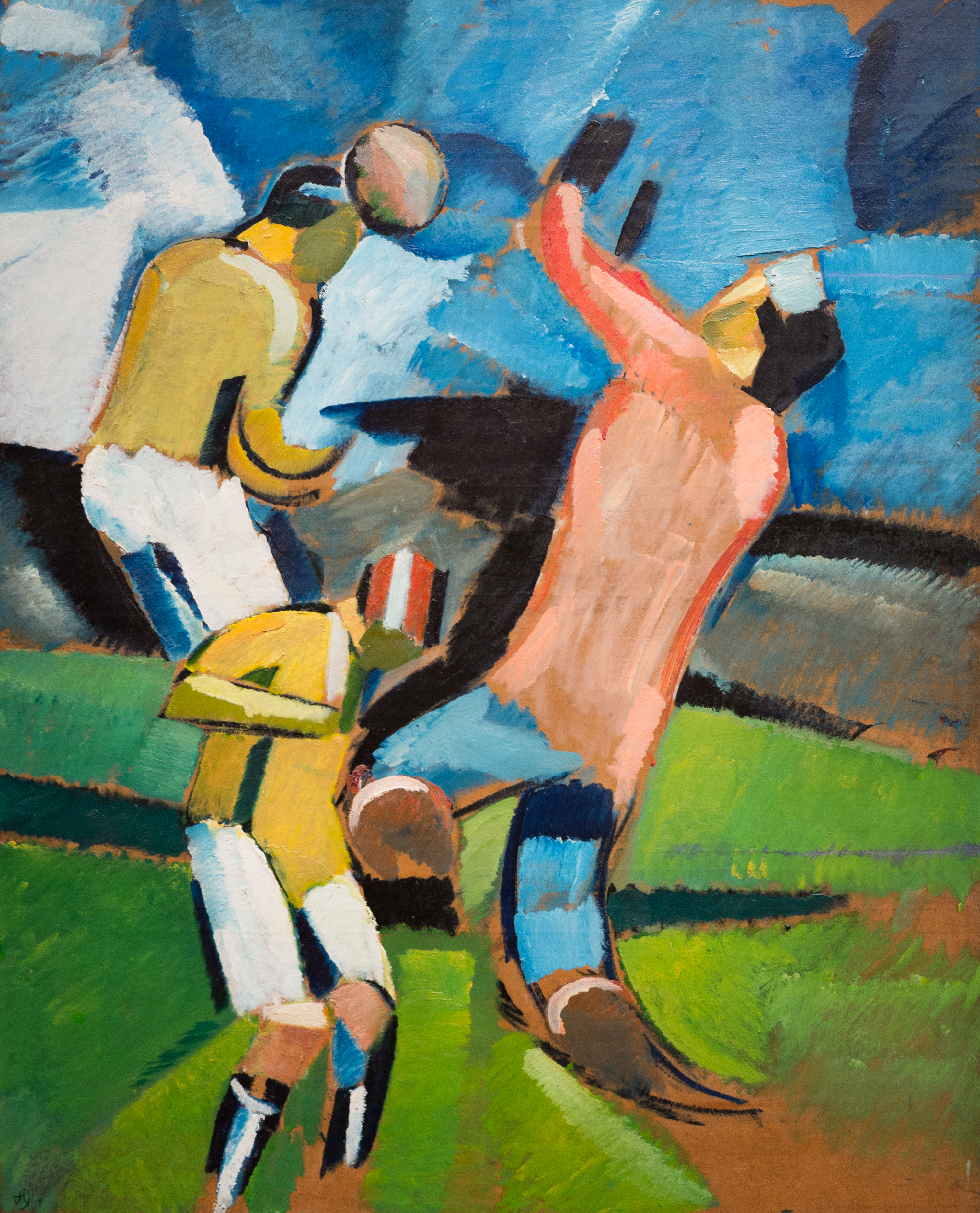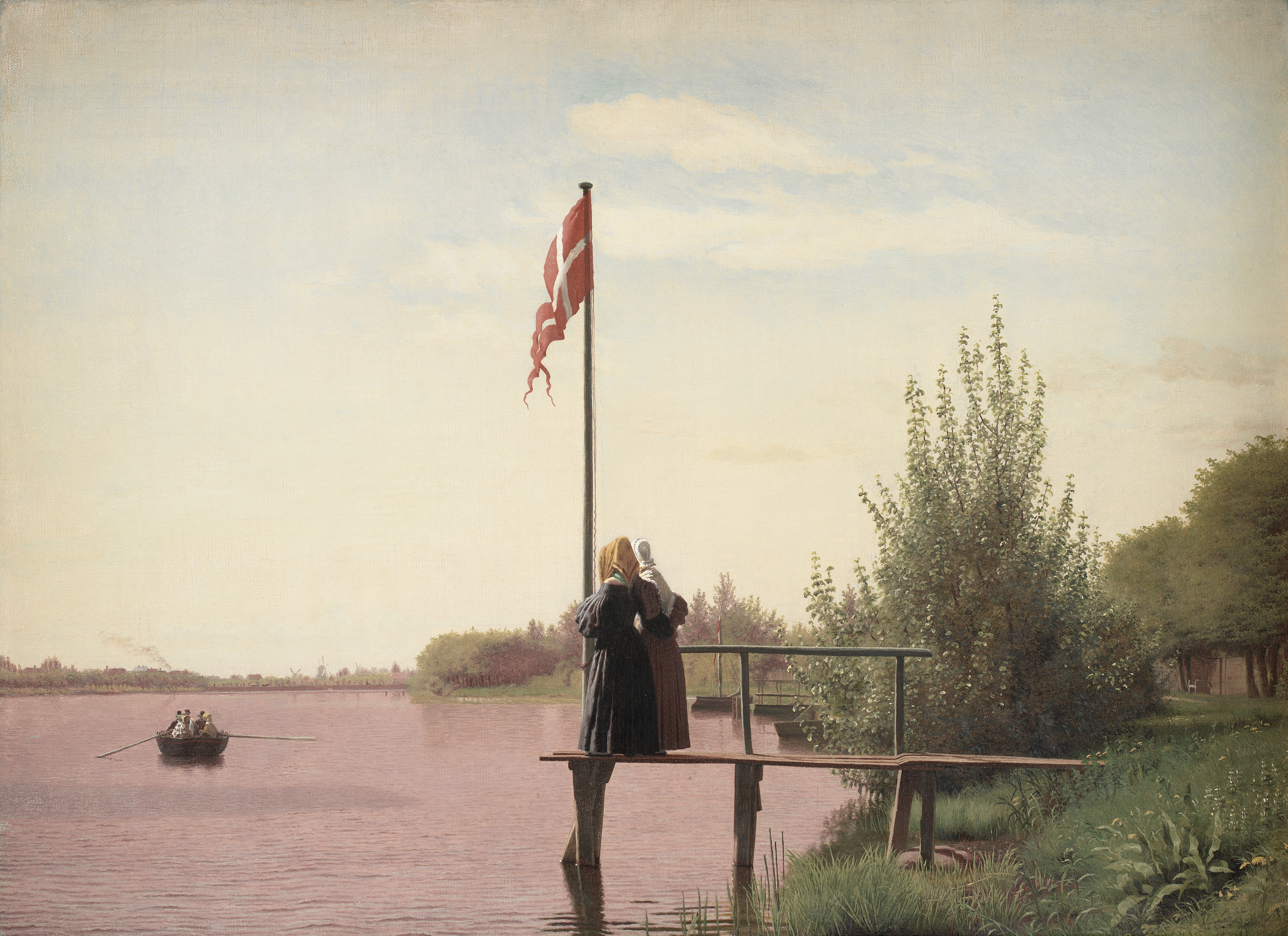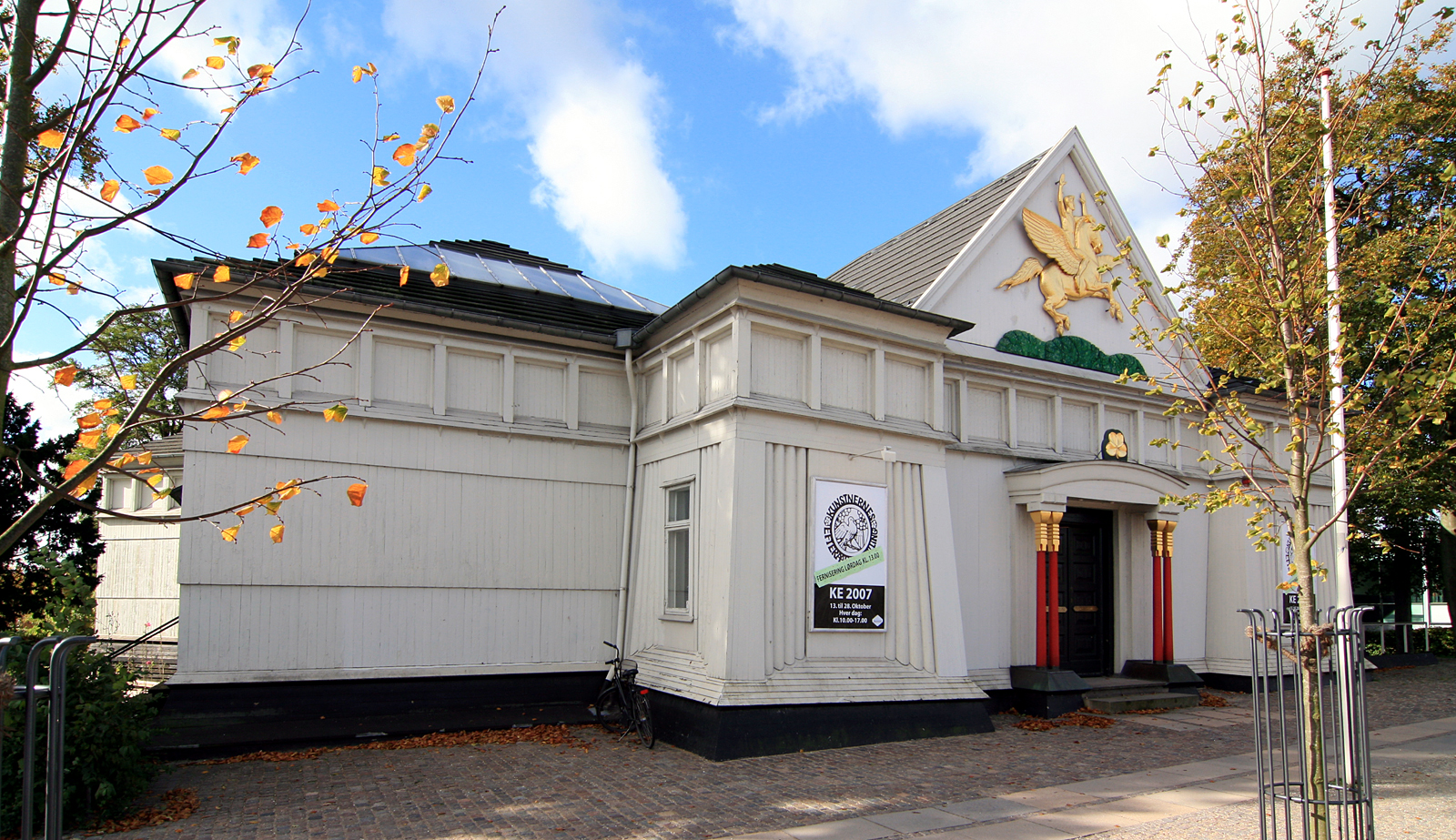|
Grønningen
Grønningen is a Danish artists cooperative whose members arrange exhibitions and similar events. Founded in 1915, it is one of the oldest and most important groupings of its kind in Denmark and currently has 54 members. It is named after the street Grønningen in Copenhagen where the first art exhibition was held. Initially, it brought together artists interested in radical and experimental art who had been members of Den Frie Udstilling ("The Free Exhibition"). Most prominent in the early years were artists such as Harald Giersing, Sigurd Swane, Olaf Rude, William Scharff, Fritz Syberg and Johannes Larsen. They were soon joined by Vilhelm Lundstrøm, Svend Johansen, Axel Salto, Jens Søndergaard, Niels Lergaard, Erik Hoppe, Christine Swane, Astrid Noack and Gottfred Eickhoff. Later came Erik Werner, Eiler Krag, Ib Spang Olsen, Lars Bo and Bo Bojesen. During the 1940s, abstract art was introduced by Richard Mortensen and Egill Jacobsen. The annual exhibitions are no ... [...More Info...] [...Related Items...] OR: [Wikipedia] [Google] [Baidu] |
Grønningen, Copenhagen
Grønningen is a street in central Copenhagen, Denmark, connecting Bredgade and the intersecting street Esplanaden, Copenhagen, Esplanaden to Oslo Plads in front of Østerport Station along the southwestern margin of the fortification Kastellet, Copenhagen, Kastellet. It lends its name to the artists' cooperative Grønningen which was originally based in the street. History The triangular area between Esplanaden, Store Kongensgade (Nyboder) and Kastellet was from 1782 home to a ropewalk. It was later converted into a Guard Hussars barracks. At the turn of the 20th century, it was decided to demolish the outdated installation to make way for high-end apartment buildings. A competition was held and a plan for redevelopment of the area was adopted by the city on 29 June 1903. Demolition of the barracks buildings began on 1 November 1905 and the area was sold to private investors shortly thereafter. A broad boulevard inspired by those of Georges-Eugène Haussmann, Haussmann in Pari ... [...More Info...] [...Related Items...] OR: [Wikipedia] [Google] [Baidu] |
Harald Giersing
Harald Giersing (24 April 1881 – 15 January 1927) was a Danish painter. He was instrumental in developing the classic modernism movement in Denmark around 1910-1920. He is remembered as one of Denmark's most important 20th-century artists both for his portraits and landscapes. Life and development Giersing, who died at the early age of 45, was driven by a desire to concentrate on change and beauty. Unable to find support in religion, he adopted modernism as an existential approach as to how art could fill the void for those without faith in God. While some synergies with the work of Vilhelm Lundstrøm can be detected, he differed from contemporaries such as Niels Larsen Stevns, Sigurd Swane and Edvard Weie in that he sought to represent images just as he had seen them, almost in the form of photographs. [...More Info...] [...Related Items...] OR: [Wikipedia] [Google] [Baidu] |
Art Of Denmark
Danish art is the visual arts produced in Denmark or by Danish artists. It goes back thousands of years with significant artifacts from the 2nd millennium BC, such as the Trundholm sun chariot. For many early periods, it is usually considered as part of the wider Nordic art of Scandinavia. Art from what is today Denmark forms part of the art of the Nordic Bronze Age, and then Norse and Viking art. Danish medieval painting is almost entirely known from church frescos such as those from the 16th-century artist known as the Elmelunde Master. The Reformation greatly disrupted Danish artistic traditions, and left the existing body of painters and sculptors without large markets. The requirements of the court and aristocracy were mainly for portraits, usually by imported artists, and it was not until the 18th century that large numbers of Danes were trained in contemporary styles. For an extended period of time thereafter art in Denmark either was imported from Germany and th ... [...More Info...] [...Related Items...] OR: [Wikipedia] [Google] [Baidu] |
Den Frie Udstilling
Den Frie Udstilling ('The Free Exhibition') is a Danish artists' association, founded in 1891 by artists in protest against the admission requirements for the Kunsthal Charlottenborg. Modeled on the Salon des Refusés, it is Denmark's oldest association of artists. Now located on Copenhagen's Oslo Plads next to Østerport Station, it works as an arts centre, continuing to exhibit works created and selected by contemporary artists rather than those chosen by cultural authorities. History The organization was initiated by the painter Johan Rohde (1856–1935) and included several founding members: Jens Ferdinand Willumsen, Anne Marie Carl-Nielsen, Vilhelm Hammershøi, Johanne Cathrine Krebs, the couple Harald and Agnes Slott-Møller, Christian Mourier-Petersen and Malthe Engelsted. The first exhibition in 1891 presented 100 works by 18 artists, including Peder Severin Krøyer, Julius Paulsen and Kristian Zahrtmann, who were among Denmark's greatest painters of the peri ... [...More Info...] [...Related Items...] OR: [Wikipedia] [Google] [Baidu] |
De Tretten
De Tretten (The Group of Thirteen), also De Tretten Kunstnere (The Thirteen Artists), was a grouping of young Danish artists who arranged their own exhibitions in Copenhagen from 1909 to 1912 in order to display works which would not have been accepted for exhibition by the then rather traditional Royal Danish Academy of Fine Arts. Background Based on the French model of the Salon des Refusés, De Tretten was founded on the initiative of Olaf Rude (who exhibited there in 1909 and 1910) and the critic Jens Pedersen. Rude had managed to obtain financial guarantees for the enterprise from those who had recently established themselves in the seaside resort of Marielyst on Falster which had been promoted as an artists colony along the lines of Skagen. Several, including Rude himself, had studied at the Kunstnernes Frie Studieskoler under Kristian Zahrtmann who had broken away from the Academy into the developing trends of Naturalism and Realism. Paintings exhibited at De Tretten were o ... [...More Info...] [...Related Items...] OR: [Wikipedia] [Google] [Baidu] |
Svend Johansen
Svend Johansen (10 September 1890 – 6 October 1970) was a Danish painter, scenographer and illustrator. Biography Born in Gentofte, Johansen attended the Copehangen Technical School where he met Poul Henningsen who became a friend and associate for the rest of his life. He studied painting at the Royal Danish Academy of Fine Arts from 1912 to 1916 under P. Rostrup Bøyesen. In 1919, he began an extended stay in France where he met Vilhelm Lundstrøm in Paris in 1922. Together with Karl Larsen and Axel Salto, Johansen and Lundstrøm settled in Bormes near Cannes, establishing the artistic group ''De Fire''. They exhibited together until 1930. Johansen became a member of the Grønningen artists association in 1933, exhibiting there for many years. His stay in Bormes had brightened up his paintings, possibly under the influence of Henri Matisse and Auguste Renoir, depicting nude women and landscapes of the south of France. In addition to richly coloured prints, he also produced po ... [...More Info...] [...Related Items...] OR: [Wikipedia] [Google] [Baidu] |
Erik Hoppe
Erik Hoppe (1896–1968) was a Danish painter who is remembered for his paintings from the Copenhagen area, especially those with young ladies in the park at Valby. Hoppe also mastered the effects of light and colour. His earlier work is typified by greens and dull shades but later he produced compositions benefitting from bright sunlight. His style reflects the peculiarly Danish form of modernism, initially based on the sombre everyday-realism of around 1930. Affinities with the work of Edvard Weie and Harald Giersing can also be detected as his style developed to a lighter, less constrained approach. This tendency was soon to lead to the Grønningen movement which brought together painters of nature and everyday life. Retri ... [...More Info...] [...Related Items...] OR: [Wikipedia] [Google] [Baidu] |
Sigurd Swane
Sigurd Swane (16 June 1879 – 9 April 1973) was a Danish Post-impressionist painter and poet; known primarily for his landscapes. Biography Swane was born in Frederiksberg. He studied in Copenhagen at the Royal Danish Academy of Art from 1899 until 1903. That year, he made his official debut at the Charlottenborg Spring Exhibition. While in Paris in 1907, he was influenced by Fauvism. On returning to Denmark, he painted a series of woodlands using greens, yellows and blues. His use of pointillistic spots was soon replaced by more solid brushstrokes, with careful separation of colour, making him one of Denmark's foremost colourists. He also did portraits, still lifes and some religious scenes, including many painted versions of "The Dream of Jacob". His portraits are typified by wooded backgrounds. In 1912 he published one of his best known collections of poems, ''Skyer'' (Clouds). Three years later, he was among the organizers of the Grønningen artists' group. His work was ... [...More Info...] [...Related Items...] OR: [Wikipedia] [Google] [Baidu] |
Olaf Rude
Olaf Rude (26 April 1886 – 17 June 1957) was a Danish painter. He was a professor at the Royal Danish Academy of Art from 1953 to 1956. He is remembered in particular for his paintings of oak trees at Skejten on Lolland, two of which can be seen at Christiansborg. Biography He was born in an area then in the Russian Empire (now in Estonia). As a child, he moved with his family to Frejlev ( Guldborgsund Municipality) on the island of Lolland. In 1905, he studied at the Copenhagen Technical School and later at the Kunstnernes Frie Studieskole where he was taught by Kristian Zahrtmann and Johan Rohde. In 1911, he travelled to Paris where he was inspired especially by Paul Cézanne. On returning to Denmark, he became one of the classic modernists who around the time of the First World War focused on formal representation concentrating on form, line and colour. His work was exhibited at Grønningen's first exhibition in 1915. In 1919, he moved to Bornholm where he specialise ... [...More Info...] [...Related Items...] OR: [Wikipedia] [Google] [Baidu] |
William Scharff
Niels William Scharff (30 October 1886– 20 September 1959) was a Danish painter, one of the leading proponents of Cubism in Denmark. Early life After training as a painter at Copenhagen's Technical School, Scharff attended Kristian Zahrtmann's art school (1907–1909) where he met young talents including Vilhelm Lundstrøm, Jais Nielsen and Olaf Rude. As a student, he travelled to Berlin, Dresden and Paris."Niels William Scharff" Gravsted.dk. Retrieved 27 January 2013. Career During the , Scharff was involved in , a new artis ...[...More Info...] [...Related Items...] OR: [Wikipedia] [Google] [Baidu] |
Gottfred Eickhoff
Gottfred Eickhoff (11 April 1902 in Frederiksberg – 26 July 1982) was a Danish sculptor. Inspired by French trends, his work contrasted with that of his predecessors, exhibiting a spirit of harmony, peace and balance. Early life After matriculating from high school in 1920, Eickhoff embarked on law studies but changed paths in 1926 when he became a pupil of Harald Giersing. Realizing he would now concentrate on sculpture, he continued his studies in Paris from 1927 to 1933 under Charles Despiau, associating with a wide range of sculptors including Jean Osouf and Paul Cornet from France, Charles Leplae from Belgium, Han Wezelaar from the Netherlands, Bror Hjorth from Sweden and Adam Fischer and Astrid Noack from Denmark."Gottfred Eickhoff" ... [...More Info...] [...Related Items...] OR: [Wikipedia] [Google] [Baidu] |
Astrid Noack
Astrid Noack (30 January 1888 – 26 December 1954) was a Danish sculptor who specialized in the human figure, creating works such as the statue of Anna Ancher in Skagen, and her ''Standing Woman (Noack), Standing Woman'' which was included in the Danish Culture Canon."Stronger than life – The Sculptor Astrid Noack 1888–1954" Thorvaldsens Museum. Retrieved 27 January 2013. Early life Noack was born in Ribe, the daughter of merchant Johan Peter N. (1831–1911) og Johanne Metdine Barkentin (1850–1913). Ugift. She was the sister of theologian Carl Wulff Noack. In 1902 Noack went to Copenhagen where she earned a living painting porcelain at the Aluminia faience factory. She then attended Vallekilde Folk High School, spec ...[...More Info...] [...Related Items...] OR: [Wikipedia] [Google] [Baidu] |




